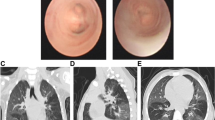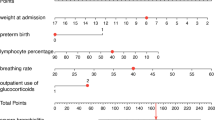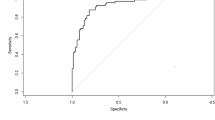Abstract
Severe adenoviral pneumonia (SAP) can cause post-infectious bronchiolitis obliterans (PIBO) in children. We aimed to investigate the relevant risk factors for PIBO and develop a predictive nomogram for PIBO in children with SAP. This prospective study analysed the clinical data of hospitalised children with SAP and categorised them into the PIBO and non-PIBO groups. Least absolute shrinkage and selection operator (LASSO) regressions were applied to variables that exhibited significant intergroup differences. Logistic regression was adopted to analyse the risk factors for PIBO. Additionally, a nomogram was constructed, and its effectiveness was assessed using calibration curves, C-index, and decision curve analysis. A total of 148 hospitalised children with SAP were collected in this study. Among them, 112 achieved favourable recovery, whereas 36 developed PIBO. Multivariable regression after variable selection via LASSO revealed that aged < 1 year (OR, 2.38, 95% CI, 0.82–6.77), admission to PICU (OR, 24.40, 95% CI, 7.16–105.00), long duration of fever (OR, 1.16, 95% CI, 1.04–1.31), and bilateral lung infection (OR, 8.78, 95% CI, 1.32–195.00) were major risk factors for PIBO. The nomogram model included the four risk factors: The C-index of the model was 0.85 (95% CI, 0.71–0.99), and the area under the curve was 0.85 (95% CI, 0.78–0.92). The model showed good calibration with the Hosmer-Lemeshow test (χ2 = 8.52, P = 0.38) and was useful in clinical settings with decision curve analysis.
Conclusion: Age < 1 year, PICU admission, long fever duration, and bilateral lung infection are independent risk factors for PIBO in children with SAP. The nomogram model may aid clinicians in the early diagnosis and intervention of PIBO.
What is Known: • Adenoviruses are the most common pathogens associated with PIBO. • Wheezing, tachypnoea, hypoxemia, and mechanical ventilation are the risk factors for PIBO. | |
What is New: • Age < 1 year, admission to PICU, long duration of fever days, and bilateral lung infection are independent risk factors for PIBO in children with SAP. • A prediction model presented as a nomogram may help clinicians in the early diagnosis and intervention of PIBO. |



Similar content being viewed by others
Availability of data and material
All data generated or analysed during this study are included in this article.
Abbreviations
- ALT:
-
Alanine aminotransferase
- CI:
-
Confidence interval
- HAdVs:
-
Human adenovirus
- IVIG:
-
Intravenous immunoglobulin
- LASSO:
-
Least absolute shrinkage and selection operator
- LDH:
-
Lactate dehydrogenase
- OR:
-
Odds ratio
- PaCO2 :
-
Partial pressure of carbon dioxide
- PIBO:
-
Post-infectious bronchiolitis obliterans
- PICU:
-
Paediatric intensive care units
- SAP:
-
Severe adenoviral pneumonia
References
Wen SH, Lin ZP, Zhang Y, Lv FF, Li HY, Zhang XY, Lin L, Zhu HH, Xu Z, Li CC, Zhang HL (2021) The epidemiology, molecular, and clinical of human adenoviruses in children hospitalized with acute respiratory infections. Front Microbiol 12:629971. https://doi.org/10.3389/fmicb.2021.629971
Chan KC, Yu MW, Cheung TWY, Lam DSY, Leung TNH, Tsui TK, Ip KI, Chau CSK, Lee SL, Yip AYF, Wong TW, Mak VCW, Li AM (2021) Childhood bronchiolitis obliterans in Hong Kong-case series over a 20-year period. Pediatr Pulmonol 56:153–161. https://doi.org/10.1002/ppul.25166
Peng L, Liu SL, Xie T, Li Y, Yang ZJ, Chen YQ, Deng LJ, Huang H, Ding XF, Chen M, Lin L, Wei SZ, Zhong LL (2023) Construction and analysis of a nomogram prediction model for post-infectious bronchiolitis obliterans in children with adenovirus pneumonia after invasive mechanical ventilation. BMC Pediatr 23:81. https://doi.org/10.1186/s12887-023-03883-9
Wang X, Tan XS, Li QB (2022) The difference in clinical features and prognosis of severe adenoviral pneumonia in children of different ages. J Med Virol 94:3303–3311. https://doi.org/10.1002/jmv.27680
Sarria EE, Mundstock E, Machado DG, Mocelin HT, Fischer GB, Furlan SP, Antonello ICF, Stein R, Mattiello R (2018) Health-related quality of life in patients with bronchiolitis obliterans. J Pediatr (Rio J) 94:374–379. https://doi.org/10.1016/j.jped.2017.07.021
Jerkic SP, Brinkmann F, Calder A, Casey A, Dishop M, Griese M, Kurland G, Niemitz M, Nyilas S, Schramm D, Schubert R, Tamm M, Zielen S, Rosewich M (2020) Postinfectious bronchiolitis obliterans in children: diagnostic workup and therapeutic options: a workshop report. Can Respir J 2020:5852827. https://doi.org/10.1155/2020/5852827
Yu XH, Ma YC, Gao Y, You HL (2021) Epidemiology of adenovirus pneumonia and risk factors for bronchiolitis obliterans in children during an outbreak in Jilin. China Front Pediatr 9:722885. https://doi.org/10.3389/fped.2021.722885
Liu D, Liu J, Zhang LP, Chen YM, Zhang Q (2022) Risk factors for post-infectious bronchiolitis obliterans in children: a systematic review and meta-analysis. Front Pediatr 10:881908. https://doi.org/10.3389/fped.2022.881908
Colom AJ, Teper AM, Vollmer WM, Diette GB (2006) Risk factors for the development of bronchiolitis obliterans in children with bronchiolitis. Thorax 61:503–506. https://doi.org/10.1136/thx.2005.044909
National Health Commission of the People’s Republic of China, State Administration of Traditional Chinese Medicine (2019) Guideline for diagnosis and treatment of community-acquired pneumonia in children (2019 version). Chin J Clin Infect Dis 12:6–13. https://doi.org/10.3760/cma.j.issn.1674-2397.2019.01.002
National Health Commission of the People’s Republic of China, State Administration of Traditional Chinese Medicine (2019) Guideline for diagnosis and treatment of adenovirus pneumonia in children (2019 version). Chin J Clin Infect Dis 12:161–166. https://doi.org/10.3760/cma.j.issn.1674-2397.2019.03.001
Yan SL, Sun C, Jiang K (2023) A diagnostic nomogram for early prediction of post-infectious bronchiolitis obliterans in severe pneumonia. J Inflamm Res 16:2041–2050. https://doi.org/10.2147/JIR.S406375
Li LM, Woo YY, de Bruyne JA, Nathan AM, Kee SY, Chan YF, Chiam CW, Eg KP, Thavagnanam S, Sam IC (2018) Epidemiology, clinical presentation and respiratory sequelae of adenovirus pneumonia in children in Kuala Lumpur, Malaysia. Plos ONE 13:e0205795. https://doi.org/10.1371/journal.pone.0205795
Lynch JP 3rd, Kajon AE (2021) Adenovirus: epidemiology, global spread of novel types, and approach to treatment. Semin Respir Crit Care Med 42:800–821. https://doi.org/10.1055/s-0041-1733802
Şişmanlar Eyüboğlu T, Aslan AT, Ramaslı Gürsoy T, Pekcan S, Köse M, Hangül M, Aral LA, Bulut V (2022) Caspase-1 and interleukin-18 in children with post infectious bronchiolitis obliterans: a case-control study. Eur J Pediatr 181:3093–3101. https://doi.org/10.1007/s00431-022-04528-2
Li LX, Fan HF, Zhou JY, Xu XH, Yang DY, Wu MH, Cao C, Lu G (2023) Human adenovirus infection induces pulmonary inflammatory damage by triggering noncanonical inflammasomes activation and macrophage pyroptosis. Front Immunol 14:1169968. https://doi.org/10.3389/fimmu.2023.1169968
Zhang JM, Xu CD, Yan SS, Zhang XF, Zhao DY, Liu F (2023) A nomogram for predicting severe adenovirus pneumonia in children. Front Pediatr 11:1122589. https://doi.org/10.3389/fped.2023.1122589
Zou M, Zhai Y, Mei XP, Wei X (2022) Lactate dehydrogenase and the severity of adenoviral pneumonia in children: a meta-analysis. Front Pediatr 10:1059728. https://doi.org/10.3389/fped.2022.1059728
Xie LY, Zhang B, Zhou JY, Huang H, Zeng SZ, Liu Q, Xie ZP, Gao HC, Duan ZJ, Zhong LL (2018) Human adenovirus load in respiratory tract secretions are predictors for disease severity in children with human adenovirus pneumonia. Virol J 15:123. https://doi.org/10.1186/s12985-018-1037-0
He YQ, Liu P, Xie LY, Zeng SZ, Lin HS, Zhang B, Liu JB (2022) Construction and verification of a predictive model for risk factors in children with severe adenoviral pneumonia. Front Pediatr 10:874822. https://doi.org/10.3389/fped.2022.874822
Liu MC, Xu Q, Li TT, Wang T, Jiang BG, Lv CL, Zhang XA, Liu W, Fang LQ (2023) Prevalence of human infection with respiratory adenovirus in China: a systematic review and meta-analysis. PLoS Negl Trop Dis 17:e0011151. https://doi.org/10.1371/journal.pntd.0011151
Wang L, Hu XT, Huang ZY, Zhang YJ, Zhao XY, Liu XH, Mao H, Hao HX, Xue WL (2023) Analysis of the typing of adenovirus and its clinical characteristics in children with acute respiratory tract infection. BMC Pediatr 23:25. https://doi.org/10.1186/s12887-023-03840-6
Chen QG, Liu J, Liang WW, Chen Y, Dou M, Liu ZM, Chen Y, Zheng ZL, Zhu B, Lin YP (2020) Clinical features, replication competence, and innate immune responses of adenovirus type 7 infection in humans. J Infect Dis 223:1390–1399. https://doi.org/10.1093/infdis/jiaa524
Sun C, Yan SL, Jiang K, Wang C, Dong XY (2021) A preliminary nomogram constructed for early diagnosis of bronchitis obliterans in children with severe pneumonia. Transl Pediatr 10:485–493. https://doi.org/10.21037/tp-20-272
Acknowledgements
All the authors thank all participants in the study for their unstinted cooperation.
Funding
The authors gratefully acknowledge the financial support from the Medical Health Science and Technology Project of Zhejiang Provincial Health Commission (Grant number 2021KY213), as well as the Basic Scientific Research Project of Wenzhou Science and Technology Bureau (Grant number Y20210001).
Author information
Authors and Affiliations
Contributions
Wen SH and Zhang HL contributed to the study design and interpreted the results. Jin WG, Zeng LY and Lin ZP collected the clinical data. Lv FF, Zhu LL collected respiratory specimens. Xu CF and Xu M analysed data. Zheng YM, Lin L and Dong L clinical followed-up. Wen SH and Xu M wrote the manuscript. Zhang HL provided critical suggestions on the results and contributed to revision of the manuscript. All authors reviewed the manuscript.
Corresponding author
Ethics declarations
Ethics approval
The study was conducted in accordance with the principles of the Declaration of Helsinki and approved by the Ethics Committee of the Second Affiliated Hospital and Yuying Children’s Hospital, Wenzhou Medical University (Approval Number No. LCKY2020-250).
Consent to participate
Participants received detailed information about the project and voluntarily agreed to participate. All participants gave their written consent to participate.
Competing interests
The authors declare no competing interests.
Additional information
Communicated by Peter de Winter
Publisher's Note
Springer Nature remains neutral with regard to jurisdictional claims in published maps and institutional affiliations.
Rights and permissions
Springer Nature or its licensor (e.g. a society or other partner) holds exclusive rights to this article under a publishing agreement with the author(s) or other rightsholder(s); author self-archiving of the accepted manuscript version of this article is solely governed by the terms of such publishing agreement and applicable law.
About this article
Cite this article
Wen, S., Xu, M., Jin, W. et al. Risk factors and prediction models for bronchiolitis obliterans after severe adenoviral pneumonia. Eur J Pediatr 183, 1315–1323 (2024). https://doi.org/10.1007/s00431-023-05379-1
Received:
Revised:
Accepted:
Published:
Issue Date:
DOI: https://doi.org/10.1007/s00431-023-05379-1




